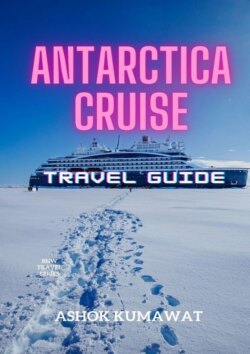Читать книгу Antarctica Cruise Travel Guide - Ashok Kumawat - Страница 6
На сайте Литреса книга снята с продажи.
Chapter 4 – Understanding Antarctica: Climate, Geography, and Wildlife
ОглавлениеTo fully appreciate the beauty and significance of Antarctica, it is essential to grasp the unique blend of climate, geography, and wildlife that characterizes this frozen continent. In this chapter, we delve into the fascinating details that make Antarctica one of the most extraordinary and awe-inspiring places on Earth.
A Land of Extremes: Climate in Antarctica
Antarctica is synonymous with extreme conditions, boasting the coldest and windiest climate on the planet. The continent experiences two distinct seasons – summer and winter.
Summer: Summer in Antarctica lasts from November to March, during which the temperatures rise to their «mildest» levels, ranging from -2° C to 8° C (28° F to 46° F). The Antarctic Peninsula experiences the most significant warming during this time, making it the primary season for expedition cruises.
Winter: Winter in Antarctica spans from April to October, bringing the most severe weather conditions. The temperatures plummet to extreme lows, often dropping below -40° C (-40° F) and even reaching -80° C (-112° F) near the interior. During this time, the continent is enveloped in darkness, with the sun barely rising above the horizon.
The Southern Ocean that surrounds Antarctica acts as a moderating influence, absorbing and releasing heat, affecting the continent’s temperatures. The ferocious winds, known as the polar vortex, can reach astonishing speeds, sculpting the landscape and defining the character of Antarctica.
Geography: A Landscape Carved by Ice
Antarctica’s geography is marked by dramatic ice formations, towering mountain ranges, and vast ice sheets that cover approximately 98% of the continent. Here are some key geographic features:
Antarctic Peninsula: The westernmost part of Antarctica, extending toward South America, is the Antarctic Peninsula. It is the most accessible region for cruise expeditions and is renowned for its stunning landscapes, active glaciers, and abundant wildlife.
East Antarctica: This vast region comprises the majority of the continent and is characterized by its massive ice sheet, some areas of which are more than 4 kilometers (2.5 miles) thick. East Antarctica is home to the South Pole and the coldest temperatures on Earth.
West Antarctica: West Antarctica is composed of ice-covered mountains and deep valleys. It is home to the West Antarctic Ice Sheet, which holds vast quantities of ice and is particularly vulnerable to climate change.
Subglacial Lakes: Hidden beneath the ice, Antarctica harbors numerous subglacial lakes. These lakes, isolated from the outside world for millions of years, have attracted scientific interest due to their potential for unique life forms and as indicators of climate change.
Transantarctic Mountains: Stretching across East Antarctica, the Transantarctic Mountains separate the continent’s eastern and western regions, contributing to the vast expanse of the Antarctic Plateau.
Remarkable Wildlife: Adaptations to Survival
Despite its harsh conditions, Antarctica hosts an astonishing array of wildlife that has adapted remarkably to thrive in this frozen wilderness. The most iconic inhabitants include:
Penguins: Several penguin species call Antarctica home, including the Adelie, Gentoo, Chinstrap, Emperor, and Macaroni penguins. These charismatic birds have evolved to be expert swimmers, relying on their streamlined bodies and powerful flippers to navigate through the frigid waters in search of food.
Seals: Antarctic seals have adapted to life both in the water and on the ice. They rely on sea ice for breeding and resting, with species such as the Weddell, Leopard, and Crabeater seals inhabiting the region.
Whales: The nutrient-rich waters of the Southern Ocean attract numerous whale species, including Humpback, Minke, Fin, and Orca whales. These magnificent marine mammals undertake long migrations to feed in these productive waters.
Birds: Antarctica is home to several seabird species, such as the Antarctic Petrel, Snow Petrel, and South Polar Skua, which have evolved to endure the cold and navigate the vast ocean expanses.
Krill: Although not readily visible, krill are a vital component of the Antarctic food web. These small, shrimp-like crustaceans form the basis of the region’s marine ecosystem, providing sustenance for many of the continent’s iconic wildlife.
Conservation and Environmental Protection
Given the fragility of the Antarctic ecosystem, conservation efforts play a paramount role in protecting its unique wildlife and pristine environment. The Antarctic Treaty System, established in 1961, designates Antarctica as a scientific preserve, prohibiting military activities and promoting international cooperation in research and environmental protection.
In 1991, the Protocol on Environmental Protection to the Antarctic Treaty was adopted, further strengthening conservation measures. This protocol designates Antarctica as a «natural reserve, devoted to peace and science,» imposing strict regulations to minimize human impacts on the region.
Scientific Research in Antarctica
Antarctica serves as a living laboratory for scientific research in fields ranging from climate change and glaciology to marine biology and astrophysics. Research stations operated by various countries host scientists who conduct groundbreaking studies on the continent and its surrounding oceans.
Conclusion: An Extraordinary World to Explore
Understanding Antarctica’s unique climate, geography, and wildlife is a gateway to appreciating the wonders that await during your cruise expedition. As you embark on this transformative journey, immerse yourself in the astonishing beauty of this frozen continent and cherish the opportunity to witness the extraordinary adaptations of its wildlife to the harshest environment on Earth.
Remember to embrace the principles of environmental stewardship, respecting the delicate ecosystem, and leaving only footprints as you explore this awe-inspiring wilderness. Antarctica’s captivating landscapes and remarkable wildlife will leave an indelible mark on your heart, enriching your life with memories that will endure for generations to come.
Bon voyage, and welcome to the majestic wonders of Antarctica!
